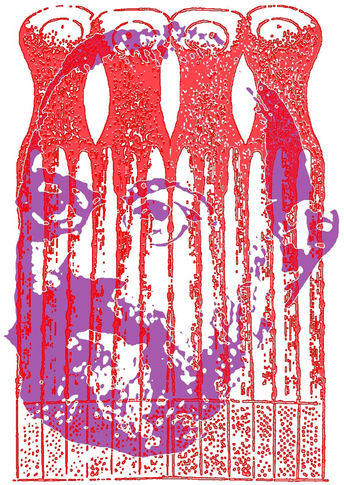Willy Kühne1837–1900
Franz Boll described the colour of rods dissected from dark adapted frog retinas as Sehrot or visual red. He conducted detailed experiments demonstrating that visual red was bleached by incident light and regenerated in darkness. After initially referring to the colour as reddish-purple he later explicitly stated that the rods were red and not purple. Why is it now referred to as visual purple? With what Boll saw as unseemly haste, Wilhelm Kühne, or Willy as he preferred to be called, not only appreciated the significance of Boll’s research but also reported extensions of it within weeks of its first publication in 1876. Kühne called it Sehpurpur (visual purple) and the chemical responsible for it was referred to as rhodopsin; these are the terms that are still in use. Kühne came relatively late to the study of the retina. He received a thorough grounding in physiology, chemistry and optics before working (like Boll) for a short time in the laboratory of du Bois-Reymond in Berlin. However, his early work was on muscle physiology, enzymes and digestion. In 1871 he succeeded Helmholtz as professor of physiology at Heidelberg and it was there that he started his investigations of retinal photochemistry. Kühne was able to extract rhodopsin from the rods of frogs and rabbits, and his elegant experiments provided the foundations upon which subsequent studies were built. He showed that the rate of bleaching was dependent not only on the intensity of light but also on its wavelength. The visual purple was confined to rods and was not seen in the foveas of humans. Most significantly, Kühne established the ‘visual cycle’: visual purple in the rods is bleached by light to form visual yellow which in turn is transformed to visual white. He wrote: “Though the knowledge gained to date about visual purple has left the question whether it has some excitatory, objectively demonstrable effects on the retina completely undecided, the phototropic reaction of the pigment epithelium offers an unambiguous answer, since it shows that light clearly has a stimulating effect on the epithelial protoplasm”. Kühne was fascinated by the similarities between the chemical processes in photographic films and in retinas. He described the relationship thus: “Bound together with the pigment epithelium, the retina behaves not merely like a photographic plate, but like an entire photographic workshop, in which the workman continually renews the plate by laying on new light-sensitive material, while simultaneously erasing the old image”. In order to display this workshop in action Kühne exposed dark-adapted, living eyes (usually of rabbits) to light and developed the retinas yielding what he called optograms – the final long-lasting stimulus (like a window) on which the eyes were fixed could be captured on the processed retina. Of all the scientific work he performed, the optograms had the greatest popular appeal, and they were applied in science fiction in a manner distinctly disapproved of by Kühne. His experiments were reported in newspapers: the notion that the retinal record at the moment of death would be retained captured the imagination of novelists and crime writers. From Jules Verne onwards the possibility that the image of the murderer was retained in their victims’ retinas was entertained. Kühne is shown (in purple) amidst the red rods that he represented.
